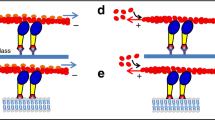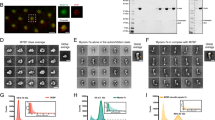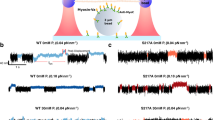Abstract
Class-V myosin proceeds along actin filaments with large (∼36 nm) steps1,2,3. Myosin-V has two heads, each of which consists of a motor domain and a long (23 nm) neck domain. In accordance with the widely accepted lever-arm model4, it was suggested that myosin-V steps to successive (36 nm) target zones along the actin helical repeat by tilting its long neck (lever-arm)5. To test this hypothesis, we measured the mechanical properties of single molecules of myosin-V truncation mutants with neck domains only one-sixth of the native length. Our results show that the processivity and step distance along actin are both similar to those of full-length myosin-V. Thus, the long neck domain is not essential for either the large steps or processivity of myosin-V. These results challenge the lever-arm model. We propose that the motor domain and/or the actomyosin interface enable myosin-V to produce large processive steps during translocation along actin.
This is a preview of subscription content, access via your institution
Access options
Subscribe to this journal
Receive 51 print issues and online access
$199.00 per year
only $3.90 per issue
Buy this article
- Purchase on Springer Link
- Instant access to full article PDF
Prices may be subject to local taxes which are calculated during checkout



Similar content being viewed by others
References
Mehta, A. D. et al. Myosin-V is a processive actin-based motor. Nature 400, 590–593 (1999).
Sakamoto, T., Amitani, I., Yokota, E. & Ando, T. Direct observation of processive movement by individual myosin V molecules. Biochem. Biophys. Res. Commun. 272, 586–590 (2000).
Rief, M. et al. Myosin-V stepping kinetics: A molecular model for processivity. Proc. Natl Acad. Sci. USA 97, 9482–9486 (2000).
Spudich, J. A. How molecular motors work. Nature 372, 515–518 (1994).
Walker, M. L. et al. Two-headed binding of a processive myosin to F-actin. Nature 405, 804–807 (2000).
Cooke, R. Myosin structure: does the tail wag the dog? Curr. Biol. 9, R773–R775 (1993).
Wakabayashi, K. et al. Small-angle synchrotron X-ray scattering reveals distinct shape changes of the myosin head during hydrolysis of ATP. Science 258, 443–447 (1992).
Corrie, J. E. et al. Dynamic measurement of myosin light-chain-domain tilt and twist in muscle contraction. Nature 400, 425–430 (1999).
Warshaw, D. M. et al. The light chain binding domain of expressed smooth muscle heavy meromyosin acts as a mechanical lever. J. Biol. Chem. 275, 37167–371672 (2000).
Ruff, C., Furch, M., Brenner, B., Manstein, D. J. & Meyhofer, E. Single-molecule tracking of myosins with genetically engineered amplifier domains. Nature Struct. Biol. 8, 226–229 (2001).
Uyeda, T. Q., Abramson, P. D. & Spudich, J. A. The neck region of the myosin motor domain acts as a lever arm to generate movement. Proc. Natl Acad. Sci. USA 93, 4459–4464 (1996).
Itakura, S. et al. Force-generating domain of myosin motor. Biochem. Biophys. Res. Commun. 196, 1504–1510 (1993).
Trybus, K. M., Krementsova, E. & Freyzon, Y. Kinetic characterization of a monomeric unconventional myosin V construct. J. Biol. Chem. 274, 27448–27456 (1999).
Perreault-Micale, C., Shushan, A. D. & Coluccio, L. M. Truncation of a mammalian myosin I results in loss of Ca2+-sensitive motility. J. Biol. Chem. 275, 21618–21623 (1999).
Homma, K., Saito, J., Ikebe, R. & Ikebe, M. Ca(2+)-dependent regulation of the motor activity of myosin V. J. Biol. Chem. 275, 34766–347671 (2000).
Wang, F. et al. Effect of ADP and ionic strength on the kinetic and motile properties of recombinant mouse myosin V. J. Biol. Chem. 275, 4329–4335 (2000).
Tanaka, H., Ishijima, A., Honda, M., Saito, K. & Yanagida, T. Orientation dependence of displacements by a single one-headed myosin relative to the actin filament. Biophys. J. 75, 1886–1894 (1998).
Ishijima, A. et al. Simultaneous observation of individual ATPase and mechanical events by a single myosin molecule during interaction with actin. Cell 92, 161–171 (1998).
Finer, J. T., Simmons, R. M. & Spudich, J. A. Single myosin molecule mechanics: piconewton forces and nanometre steps. Nature 368, 113–119 (1994).
Molloy, J. E., Burns, J. E., Kendrick-Jones, J., Tregear, R. T. & White, D. C. Movement and force produced by a single myosin head. Nature 378, 209–212 (1995).
Stryer, L. Biochemistry 4th edn, 443–462 (Freeman, New York, 1995).
Dupuis, D. E., Guilford, W. H., Wu, J. & Warshaw, D. M. Actin filament mechanics in the laser trap. J. Muscle Res. Cell Motil. 18, 17–30 (1997).
De La Cruz, E. M., Wells, A. L., Rosenfeld, S. S., Ostap, E. M. & Sweeney, H. L. The kinetic mechanism of myosin V. Proc. Natl Acad. Sci. USA 96, 13726–13731 (1999).
Tsuda, Y., Yasutake, H., Ishijima, A. & Yanagida, T. Torsional rigidity of single actin filaments and actin-actin bond breaking force under torsion measured directly by in vitro micromanipulation. Proc. Natl Acad. Sci. USA 93, 12937–12942 (1996).
Ikebe, M. et al. A hinge at the central helix of the regulatory light chain of myosin is critical for phosphorylation-dependent regulation of smooth muscle myosin motor activity. J. Biol. Chem. 273, 17702–17707 (1998).
Mercer, J. A., Seperack, P. K., Strobel, M. C., Copeland, N. G. & Jenkins, N. A. Novel myosin heavy chain encoded by murine dilute coat colour locus. Nature 349, 709–713 (1991).
Homma, K., Yoshimura, M., Saito, J., Ikebe, R. & Ikebe, M. The core of the motor domain, not the lever-arm/converter domain, determines the direction of myosin movement. Nature 412, 831–834 (2001).
Katayama, E. The effects of various nucleotides on the structure of actin-attached myosin subfragment-1 as studied by quick-freeze deep-etch electron microscopy. J. Biochem. 106, 751–770 (1989).
Acknowledgements
We are grateful to N. Jenkins for providing cDNA fragments of mouse myosin-V. We thank colleagues at the Single Molecule Processes Project, University of Massachusetts Medical School, and Osaka University for discussions, and J. West for critically reading the manuscript. This work was supported by grants from the National Institute of Health to M.I.
Author information
Authors and Affiliations
Corresponding authors
Rights and permissions
About this article
Cite this article
Tanaka, H., Homma, K., Iwane, A. et al. The motor domain determines the large step of myosin-V. Nature 415, 192–195 (2002). https://doi.org/10.1038/415192a
Received:
Accepted:
Issue Date:
DOI: https://doi.org/10.1038/415192a
This article is cited by
-
Melanophilin Stimulates Myosin-5a Motor Function by Allosterically Inhibiting the Interaction between the Head and Tail of Myosin-5a
Scientific Reports (2015)
-
Coupling of Two Non-processive Myosin 5c Dimers Enables Processive Stepping along Actin Filaments
Scientific Reports (2014)
-
The path to visualization of walking myosin V by high-speed atomic force microscopy
Biophysical Reviews (2014)
Comments
By submitting a comment you agree to abide by our Terms and Community Guidelines. If you find something abusive or that does not comply with our terms or guidelines please flag it as inappropriate.



